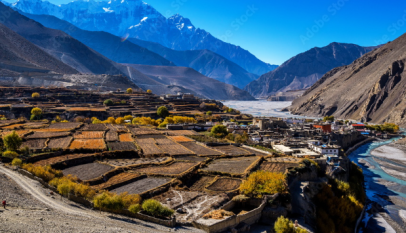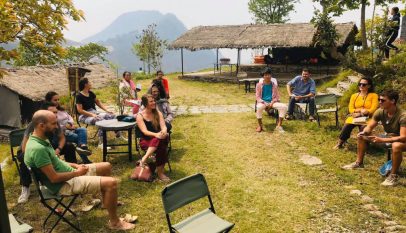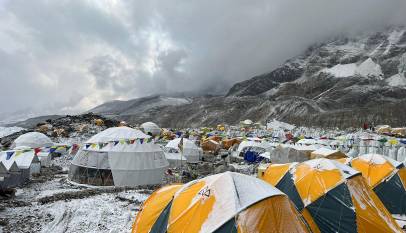Exotic Tamang culture
- Sushant Lama

Nepal is depicted to be poor in physical infrastructures, yet it is prosperous in natural resources, mountains, rivers, lakes, and landscapes. The aesthetic value of all this richness is beyond comparisons. And on top of that Nepal’s multi-ethnic cultures, traditions, festivals continue to attract tourists as part and parcel of cultural tourism. So, let me introduce you to one of the ancient ethnic cultures of Tamang Community.
Tamang community is the indigenous inhabitants of Nepal with Tibeto-Burman speaking communities whose ancestry could be traced from Tibet. They have a definite culture, language, and tradition. They inhabit sparsely in all of Nepal but mostly live in districts like Kathmandu, Rasuwa, Nuwakot, Dhading, Makawanpur, Sindhuli, Ramechhap, Dolakha, Lalitpur, Sindhupalchok and Kavrepalanchok. They also reside out of Nepal in various places like Darjeeling, Sikkim, Nagaland, Assam of India and the adjoining region of Bhutan and Myanmar.

The origin of Tamang is not exactly known but the most common belief is that they may have broken away from Tibet. It is said that the word “Tamang” was derived from the Tibetan word Tamag, in which ‘Ta’ means ‘horse’ and ‘Mag‘ refers to ‘rider’ meaning Tamang people were horse riders or soldiers riding a horse.
It is also believed that after the Nepal-Tibet war, some of the horse-riding soldiers of Tibetian King Tsrong Tschong Gampo had settled permanently in the Himalayan hills and were, later, called Tamangs but some experts oppose this theory.
According to some scholars, in Tibetan ‘Ta’ means ‘entrance/gateway’ and ‘Mang’ means ‘large public or common people’. So, ‘Tamang’, in Tibetan means presence of large number of people at the entrance or boundary, which signifies the settlement of Tamang people in the border of Tibet and Nepal which is also supported by the Tibetan usage of the word ‘Rongpo’ for Tamang, which means the foreigners, inhabited beyond the border of Tibet.
Their ancestral land is popularly known as Tamsaling in which ‘Tam’ refers to the language spoken by Tamang people, ‘Sa’ means land and ‘Ling’ refers to territory and combined means land of Tamang language speaking people. Tamangs have their own distinct language ‘Tamang’ which falls in Tibeto-Burman language group.
Most of the Tamang people speak in their mother tongue. Their original script is known as Sambhota, but some organizations like Nepal Tamang Ghedung are using a modified version of Sambhota script known as Tamyig.
Tamang Culture

Tamangs mostly believe in ‘Bon’ Dharma and are the followers of Buddhism. According to the census of 2011 Tamangs are the largest population who follow Buddhism in Nepal. They follow the Buddhist cultural system which has a system of six social leaders, Tamba, Ganba, Bonbo, Labonbo, Lama, and Choho to keep the Tamang Society alive from generation to generation. Those Six social leaders have their respective duties in society.
The Tamba looks after the cultural aspect and has a very important role to play in marriage ceremonies in the community. The Lama carries out death rituals (Ghewa) and undertakes activities related to the Buddhist religion.
The Bonbo satisfies the local gods and goddesses and assists by providing treatment to the sick and needy people in the village. The Labonbo (Laptaba) keeps alive the history of the clan and lineage through the worship of various clan deities. The Choho looks into cases of justice and maintains peace, security, and wellbeing in the community.
The Ganba participates in all types of social, political and religious activities conducted in society. He also evaluates whether other social leaders like Tamba, Bonbo, Lama, Labtaba, Choho, etc have fulfilled their functions according to rituals or not and gives his suggestions. Therefore, the six social leaders continue to make the Tamang society aware of their duties and responsibilities.
There are numerous different clans and family-sects within the Tamang community. Institutions like Nhangkhor play important roles in conducting the socio-cultural activities of the community. Nyingma which is the oldest of the four major schools of Tibetan Buddhism is followed by most of the Tamangs. They also practice the tradition of ancestors and worship many deities and guardians like the deities of Khappa, Soong, Foopshang, Mraapsoong, family deity, place deity, and clan deity, etc. Deities differ from clan to clan.
Marriage

Tamang marriage ceremony is conducted according to their traditional rituals. Tamang man can marry any girl from any clan but cannot marry a girl from a different caste. Preferred marriage is between cross-cousins that is to one’s mother’s brother’s daughter or father’s sister’s daughter. Parallel-cousin marriage of a man to his father’s brother’s daughter or mother’s sister’s daughter is strictly prohibited.
Similarly, in the Tamang community, the Solta and Soltini before marrying should give the Karshyol pong (Sagun) which also means good luck and some money to the Soltini’s house. Karshyol pond is the wooden hollow cylinder that is used to carry the alcohol during the festival.
When Karshyol pong is accepted by a girl then only marriage is fixed and if the girl denies the Karshyol pong then the marriage is denied. When the girl accepts the pong but the girl is abducted by another man then that man should pay double money for the first man who already gave the Karshyol pong and money. Similarly, a widow can marry a widow person and polygamy is prohibited in the community.
Tamang Music
Tamang’s favorite musical instrument is the Damphu which is made of a wooden circle with dry skin on one side of the circle tightened with the help of bamboo sticks and creates a melodious sound when played with hands and fingers. Damphu is a part of Tamang people’s culture and lifestyle and is used in every event in Tamang culture like marriage, funeral, special occasion, ritual, and festivals. They also have their song called Tamang Selo which is one of the most popular traditional Nepali music.
Festivals

Buddha Jayanti which falls on Baisakh Purnima is the most important festival for Buddhist Tamangs. This is the day when Lord Buddha was born, enlightened and gave first teaching about four noble truths. On this day they pay a visit to Monasteries and Buddhist temples like Swyambhunath, Bouddhanath and offer Khatag to Lord Buddha.
Tamangs all around the world celebrates in the same way. Sonam Lhosar is another important festival of Tamang. Lhosar means New Year in Tamang language in which ‘Lho’ refers to the year and ‘Chhar’ refers to new. On this day too they visit religious places. Not only have these they also celebrate other festivals like Dashain, Tihar, Janaipurima, etc.
Food and Occupation

Tamangs are experts in many crafts and activities and are involved in the various occupations. Some are involved in works like weaving sheep wool jackets, bamboo baskets, some are carpenters, builders, masons, and wooden plow makers, some in Thanka paintings and carving designs in wood, some in mountaineering, athletics, farmers, coolies, etc.
They mostly eat what they grow like potatoes, maize, rice, wheat, millet, etc. They also eat the meat of buffalo, goat, sheep, etc. however, do not allow pigs meat, garlic, in their houses although they might eat it if cooked outside the house or someone else’s house.
Clothing
Tamang people have their traditional dress. Their clothing is called Tamang dress which includes lungi, jewelry, patuka, cholo, Tamang mala, and Tamang ghalek. They wear this dress on special occasions of the community such as festivals of “Sonam Lhocchar.”
Mustang as international tourist destination
Luring Mustang as one of the top tourist destinations in Nepal involves highlighting its u…









